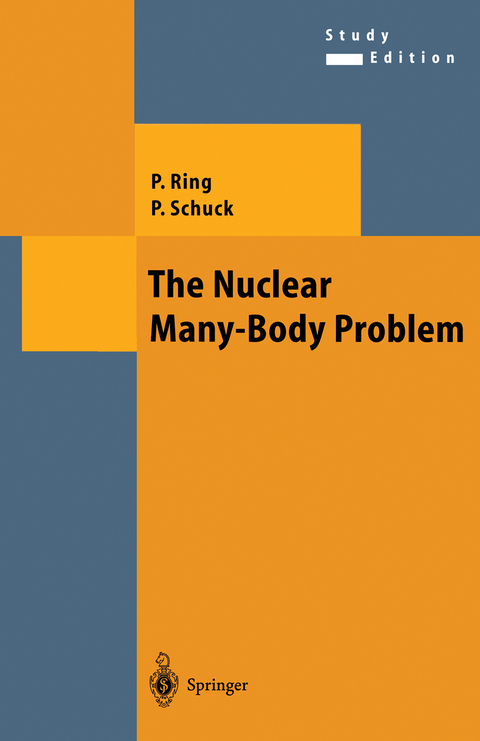
The Nuclear Many-Body Problem
Springer Berlin (Verlag)
978-3-540-21206-5 (ISBN)
1 The Liquid Drop Model.- 1.1 Introduction.- 1.2 The Semi-empirical Mass Formula.- 1.3 Deformation Parameters.- 1.4 Surface Oscillations About a Spherical Shape.- 1.5 Rotations and Vibrations for Deformed Shapes.- 1.6 Nuclear Fission.- 1.7 Stability of Rotating Liquid Drops.- 2 The Shell Model.- 2.1 Introduction and General Considerations.- 2.2 Experimental Evidence for Shell Effects.- 2.3 The Average Potential of the Nucleus.- 2.4 Spin Orbit Coupling.- 2.5 The Shell Model Approach to the Many-Body Problem.- 2.6 Symmetry Properties.- 2.7 Comparison with Experiment.- 2.8 Deformed Shell Model.- 2.9 Shell Corrections to the Liquid Drop Model and the Strutinski Method.- 3 Rotation and Single-Particle Motion.- 3.1 Introduction.- 3.2 General Survey.- 3.3 The Particle-plus-Rotor Model.- 3.4 The Cranking Model.- 4 Nuclear Forces.- 4.1 Introduction.- 4.2 The Bare Nucleon-Nucleon Force.- 4.3 Microscopic Effective Interactions.- 4.4 Phenomenological Effective Interactions.- 4.5 Concluding Remarks.- 5 The Hartree-Fock Method.- 5.1 Introduction.- 5.2 The General Variational Principle.- 5.3 The Derivation of the Hartree-Fock Equation.- 5.4 The Hartree-Fock Method in a Simple Solvable Model.- 5.5 The Hartree-Fock Method and Symmetries.- 5.6 Hartree-Fock with Density Dependent Forces.- 5.7 Concluding Remarks.- 6 Pairing Correlations and Superfluid Nuclei.- 6.1 Introduction and Experimental Survey.- 6.2 The Seniority Scheme.- 6.3 The BCS Model.- 7 The Generalized Single-Particle Model (HFB Theory).- 7.1 Introduction.- 7.2 The General Bogoliubov Transformation.- 7.3 The Hartree-Fock-Bogoliubov Equations.- 7.4 The Pairing-plus-Quadrupole Model.- 7.5 Applications of the HFB Theory for Ground State Properties.- 7.6 Constrained Hartree-Fock Theory (CHF).- 7.7 HFB Theory in the Rotating Frame(SCC).- 8 Harmonic Vibrations.- 8.1 Introduction.- 8.2 Tamm-Dancoff Method.- 8.3 General Considerations for Collective Modes.- 8.4 Particle-Hole Theory with Ground State Correlations (RPA).- 8.5 Linear Response Theory.- 8.6 Applications and Comparison with Experiment.- 8.7 Sum Rules.- 8.8 Particle-Particle RPA.- 8.9 Quasi-particle RPA.- 9 Boson Expansion Methods.- 9.1 Introduction.- 9.2 Boson Representations in Even-Even Nuclei.- 9.3 Odd Mass Nuclei and Particle Vibration Coupling.- 10 The Generator Coordinate Method.- 10.1 Introduction.- 10.2 The General Concept.- 10.3 The Lipkin Model as an Example.- 10.4 The Generator Coordinate Method and Boson Expansions.- 10.5 The One-Dimensional Harmonic Oscillator.- 10.6 Complex Generator Coordinates.- 10.7 Derivation of a Collective Hamiltonian.- 10.8 The Choice of the Collective Coordinate.- 10.9 Application of the Generator Coordinate Method for Bound States.- 11 Restoration of Broken Symmetries.- 11.1 Introduction.- 11.2 Symmetry Violation in the Mean Field Theory.- 11.3 Transformation to an Intrinsic System.- 11.4 Projection Methods.- 12 The Time Dependent Hartree-Fock Method (TDHF).- 12.1 Introduction.- 12.2 The Full Time-Dependent Hartree-Fock Theory.- 12.3 Adiabatic Time-Dependent Hartree-Fock Theory (ATDHF).- 13 Semiclassical Methods in Nuclear Physics.- 13.1 Introduction.- 13.2 The Static Case.- 13.3 The Dynamic Case.- Appendices.- A Angular Momentum Algebra in the Laboratory and the Body-Fixed System.- B Electromagnetic Moments and Transitions.- B.l The General Form of the Hamiltonian.- B.2 Static Multipole Moments.- B.3 The Multipole Expansion of the Radiation Field.- B.4 Multipole Transitions.- B.5 Single-Particle Matrix Elements in a Spherical Basis.- B.6 Translational Invariance and Electromagnetic Transitions.-B.7 The Cross Section for the Absorption of Dipole Radiation.- C Second Quantization.- C.1 Creation and Annihilation Operators.- C.2 Field Operators in the Coordinate Space.- C.3 Representation of Operators.- C.4 Wick's Theorem.- D Density Matrices.- D.l Normal Densities.- D.2 Densities of Slater Determinants.- D.3 Densities of BCS and HFB States.- D.4 The Wigner Transformation of the Density Matrix.- E Theorems Concerning Product Wave Functions.- E.l The Bloch-Messiah Theorem [BM 62].- E.2 Operators in the Quasi-particle Space.- E.3 Thouless' Theorem.- E.4 The Onishi Formula.- E.5 Bogoliubov Transformations for Bosons.- F Many-Body Green's Functions.- F.l Single-Particle Green's Function and Dyson's Equation.- F.2 Perturbation Theory.- F.3 Skeleton Expansion.- F.4 Factorization and Brückner-Hartree-Fock.- F.5 Hartree-Fock-Bogoliubov Equations.- F.6 The Bethe-Salpeter Equation and Effective Forces.- Author Index.
From the reviews:
"The monography by Peter Ring and Peter Schuck covers the techniques used to solve the nuclear many-body problem ... . is recognized as a reference by the nuclear physics community. Theoretical developments are explained pedagogically, with a constant rigour, are well documented and are illustrated with suitably chosen examples. The book contains a lot of references ... . It is served by a concise style. By its scope and rigour, it has no real rival and will expectedly remain a familiar introductory text in nuclear structure theory for many years." (Joseph Cugnon, Physicalia, Vol. 57 (3), 2005)
"In many ways, the 1950s through to the 1970s may be seen as a golden period for the development of nuclear physics, both experimental and theoretical. ... The book contains an excellent description of many basic theoretical methods, which continue to be relevant today, it is still of value to specialist students of nuclear theory." (J. P. Elliott, Contemporary Physics, Vol. 46 (6), 2005)
| Erscheint lt. Verlag | 25.3.2004 |
|---|---|
| Reihe/Serie | Theoretical and Mathematical Physics |
| Zusatzinfo | XVIII, 718 p. 4 illus. |
| Verlagsort | Berlin |
| Sprache | englisch |
| Maße | 155 x 235 mm |
| Gewicht | 1078 g |
| Themenwelt | Naturwissenschaften ► Physik / Astronomie ► Atom- / Kern- / Molekularphysik |
| Naturwissenschaften ► Physik / Astronomie ► Plasmaphysik | |
| Schlagworte | Body • Hardcover, Softcover / Physik, Astronomie/Atomphysik, Kernphysik • Hartree-Fock Theory • HC/Physik, Astronomie/Atomphysik, Kernphysik • Kernphysik • Many-Body Problem • nuclear physics • Vielteilchentheorie |
| ISBN-10 | 3-540-21206-X / 354021206X |
| ISBN-13 | 978-3-540-21206-5 / 9783540212065 |
| Zustand | Neuware |
| Haben Sie eine Frage zum Produkt? |
aus dem Bereich


